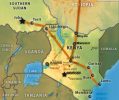OPINION – By Moono Mupotola
Lamu Port, South Sudan, Ethiopia Transport Corridor Project (LAPSSET) won the prestigious Global Infrastructure Leadership Forum Award in Washington DC on March 10th this year. The project was up against equally critical multi-billion dollar programmes including Mexico City New International airport and Seine-Nord Europe Canal, connecting northern European countries such as Belgium, Germany and the Netherlands.
LAPSSET’s award in the job creation category honours leaders “driving the next generation’s most transformative global infrastructure projects.” Since inception in 2012, LAPSSET has created an estimated 5,000 direct jobs for the 500- kilometre road between Isiolo in Kenya and Moyale, a market town on the border of Ethiopia and Kenya. Opportunities in engineering designs around the Port of Lamu, banking, telecommunications, energy generation are still available.
LAPSSET, a flagship project of the Programme for Infrastructure Development in African (PIDA) and highlighted at the 2016 PIDA week has set the path. Once completed the project is anticipated to inject 2 to 3 % in Kenya’s GDP but also position the country as an economic hub in East Africa. We are convinced that the 51 priority projects identified under PIDA in the areas of energy, transport, ICT and trans-boundary water will follow suit.
Creating productive jobs remains a key challenge in sub-Saharan Africa where nine out of ten workers in both rural and urban areas are estimated to hold only informal jobs (ILO, 2009). By 2050, Africa’s population is predicted to double to at least 2.4 billion leading to increased demand for energy. To meet this demand by 2040, US $43 billion dollars of annual capital investment is required.
The good news is that the process of lighting up Africa, one of the AfDB’s High 5s, offers great prospects for employment and skill transfer in Africa. Africa will need a cross-section of skilled workers such as plant design and site engineers, maintenance workers and semi-and low- skilled technicians for infrastructure construction.
The answer is not to only build skills but to ensure transfer of skills. This will improve our manufacturing productive capacity and thereby accelerate Africa industrialisation. PIDA 2016 was also an opportunity to learn from other developing countries. When India invested in solar energy it did so by ensuring that solar panels and related components where manufactured in the country.
India is already reaping the benefits of the huge job creation potential offered by the solar project value chain. According to the Natural Resources Defence Council (NRDC), solar and wind renewable energy projects have created some 79,000 full time jobs as of November 2015.
A 2015 report by India’s Council of Energy, Environment and Water (CEEW) shows that as many as 1 million jobs could be created if India achieves its target of 100 GW solar energy programme by 2022.
In the Philippines, a country the size of Côte d’Ivoire with a population of over 96 million inhabitants, solar technologies have been in use in for several years in remote areas. Today, the electrification rate in the country stands at 87.5 p% with urban electrification rate at 94 % and rural at 73 % (source World Bank). We need to learn from the Philippines to fast-track Africa’s transformation by improving access to energy.
PIDA Week 2016 offered a platform for International financiers, policy experts, the private sector, PIDA project owners to exchange views and share experience with the attending delegation from Peru. The Latin American country has made big strides in urban transportation with investment of US$8.82bn in road, rail, port and airport infrastructure since 2011.
For Ernst & Young, the investment will help reduce the amount of time wasted in transit estimated at 4bn/y man-hours. The firm further indicates that local investors have lined up at least US$40.1bn in infrastructure, transport and energy investment projects for 2016-2017. Peru has US$14.5bn pending in PPP infrastructure investments, equivalent to 8% of GDP.
These key achievements have prompted the AU, NEPAD, and AfDB to renew their call for increased private sector participation in PIDA projects.
PIDA Week 2016 ended on a positive consensus to fast-track infrastructure project delivery in Africa. Experts agree that there is a direct correlation between infrastructure and GDP growth. In general, around 6.5 per cent is contributed by infrastructure services in low income countries.
Africa’s youth unemployment should not be seen as “ticking time bomb” but rather a chance for our creative youth to embrace new opportunities offered in infrastructure development. There are no quick fixes to job creation to achieve shared growth for future generations. As Maya Angelou once said: “We may encounter many defeats but we must not be defeated.” Failure is just not an option.
EDITOR’S NOTE: The writer Moono Mupotola is the Director of the NEPAD Regional Integration and Trade Department at the African Development Bank (AfDB)

